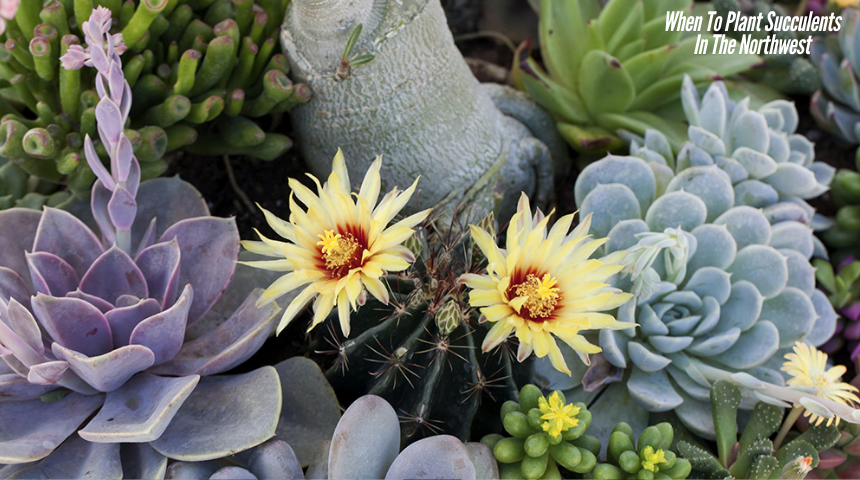I always plan my succulent planting carefully. Knowing when to plant succulents in the Northwest is crucial. The right timing ensures they thrive in this unique climate. I prefer spring or early summer for most varieties.
The soil is warmer, and there’s less risk of frost. Late summer works too, but I avoid planting in cold or wet months. Succulents need time to establish before winter. I check the forecast for dry days before planting.
Excessive rain can harm these plants. I always use well-draining soil to prevent root rot. Healthy succulents depend on proper timing. Following these steps ensures success.
When To Plant Succulents In The Northwest
I plant succulents in spring or early summer when the soil warms up and the risk of frost is low. Late summer can also work. However, I avoid planting in fall or winter, as wet and cold conditions harm succulents.
I check the weather forecast before planting. Dry days are best for planting. Proper timing helps succulents thrive. When planting, I focus on well-draining soil. This keeps the roots healthy and prevents rot. I avoid overwatering after planting.

Succulents need time to adjust to their new spot. Too much water can damage them. I plant in areas with plenty of sunlight. Good sunlight helps them grow strong and vibrant. Planting at the right time and caring properly ensures success.
Selecting The Right Species
Choosing the right succulent species is crucial for success in the Northwest. I prioritize hardy varieties that can handle cooler temperatures and damp conditions. Sedums and sempervivums are excellent choices, as they tolerate rain and thrive in less sunlight.
I avoid delicate succulents like certain echeverias, which struggle in this climate. When selecting, I consider the plant’s natural habitat. Species adapted to similar weather perform better. I look for succulents with thick leaves; they store water well and resist rot.
Visiting local nurseries helps me find suitable options. Native or regionally grown plants are often the best picks. Choosing wisely saves time and effort. Proper selection ensures a thriving succulent garden.
When To Plant
I plant succulents in the Northwest during spring or early summer. This timing ensures the soil is warm enough for root growth. Frost is unlikely during these months, which protects the plants.
Late summer is another option, but I ensure there’s time for the roots to establish before cooler weather. Planting during the rainy season or winter is risky. Excessive moisture leads to root rot and plant damage. I monitor the forecast for a few dry days before planting.

Timing matters for healthy succulents. I give my plants the best chance to adapt and grow strong by planting at the right time.
Where To Plant
Choosing the right location is essential for succulents in the Northwest. I pick areas with plenty of sunlight, ideally 4-6 hours daily. The morning sun is best, as it’s less harsh than the afternoon rays. Good drainage is a top priority for me.
I avoid low spots where water collects. Raised beds or pots with drainage holes work well. I add gravel or sand to improve soil drainage if planting in the ground.

A sunny, well-drained spot is key. The right placement prevents issues like root rot and weak growth. Thoughtful planning makes a big difference in the success of my succulents.
Providing Protection
Succulents in the Northwest need protection from excessive rain and frost. I use covers or move potted plants under shelter during heavy rain. Frost blankets or cloches help during unexpected cold snaps. I avoid leaving succulents in overly shaded or damp areas.
Mulching with gravel around the base helps prevent splashing and keeps the plants drier. Protection is essential in this climate. During winter, I bring tender succulents indoors or to a greenhouse. Careful measures ensure my succulents stay healthy year-round.
Bring The Desert Vibe To The Rainy PNW
Creating a desert vibe in the rainy Northwest is possible with succulents. I focus on drought-tolerant species that thrive despite the moisture. Using gravel or sand as top dressing enhances the desert look. I arrange plants in clusters to mimic natural desert formations.

Adding driftwood or rocks creates texture and interest. The right setup transforms any space. I incorporate terracotta pots for a warm, rustic feel. These pots also improve drainage. A well-thought-out design brings a slice of the desert to my rainy garden.
Creating A Northwest Succulent Garden
Building a succulent garden in the Northwest takes planning and care. I start by choosing a well-drained site with plenty of sunlight. Raised beds or containers work best for wet climates.
I select hardy succulents that can handle cooler temperatures. Using gravel or sandy soil ensures good drainage. I arrange plants with taller species in the back and smaller ones up front for visual appeal.
Attention to detail creates a stunning garden. Adding decorative elements like rocks or driftwood completes the look. Regular care, like checking for pests or rot, keeps the garden thriving.
FAQ
What is the best month to plant succulents?
The best month is usually May. The soil is warm, and frost risks are minimal.
Do succulents like full sun or shade?
Most succulents prefer full sun. However, some tolerate partial shade in hotter climates.
Which season is best for succulents?
Spring is the best season for planting. Early summer also works well in many regions.
Conclusion
Growing succulents in the Northwest is rewarding with the right approach. By selecting hardy species and planting at the right time, I set my garden up for success.
Proper location, protection, and care to ensure my succulents thrive despite the region’s challenges. Bringing a desert vibe to a rainy area adds beauty and uniqueness.
Succulent gardening combines creativity and resilience. With careful planning, anyone can enjoy these versatile plants in their garden.



